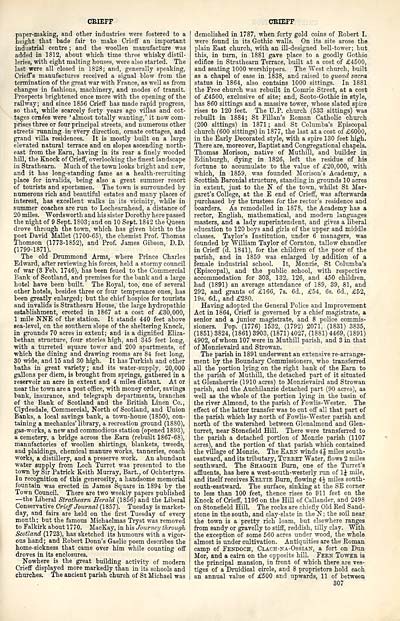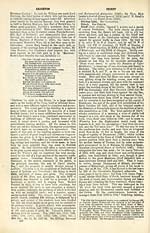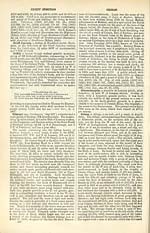Ordnance gazetteer of Scotland
(315) Page 307
Download files
Complete book:
Individual page:
Thumbnail gallery: Grid view | List view

CRIEFF
paper-making, and other industries were fostered to a
height that bade fair to make Crieff an important
industrial centre ; and the woollen manufacture was
added in 1812, about which time three whisky distil-
leries, with eight malting houses, were also started. The
last were all closed in 1828; and, generally speaking,
CriefFs manufactures received a signal blow from the
termination of the great war with France, as well as from
changes in fashions, machinery, and modes of transit.
Prospects brightened once more with the opening of the
railway; and since 1856 Crieff has made rapid progress,
so that, while scarcely forty years ago villas and cot-
tages orn£es were ' almost totally wanting, ' it now com-
prises three or four principal streets, and numerous other
streets running iff every direction, ornate cottages, and
grand villa residences. It is mostly built on a large
elevated natural terrace and on slopes ascending north-
east from the Earn, having in its rear a finely wooded
hill, the Knock of Crieff, overlooking the finest landscape
in Strathearn. Much of the town looks bright and new,
and it has long-standing fame as a health-recruiting
place for invalids, being also a great summer resort
of tourists and sportsmen. The town is surrounded by
numerous rich and beautiful estates and many places of
interest, has excellent walks in its vicinity, while in
summer coaches are run to Lochearnhead, a distance of
20 miles. Wordsworth and his sister Dorothy here passed
the night of 9 Sept. 1803; and on 10 Sept. 1842 the Queen
drove through the town, which has given birth to the
poet David Mallet (1700-65), the chemist Prof. Thomas
Thomson (1773-1852), and Prof. James Gibson, D.D.
(1799-1871).
The old Drummond Arms, where Prince Charles
Edward, after reviewing his forces, held a stormy council
of war (3 Feb. 1746), has been feued to the Commercial
Bank of Scotland, and premises for the bank and a large
hotel have been built. The Royal, too, one of several
other hotels, besides three or four temperance ones, has
been greatly enlarged; but the chief hospice for tourists
and invalids is Strathearn House, the large hydropathic
establishment, erected in 1867 at a cost of £30,000,
1 mile NNE of the station. It stands 440 feet above
sea-level, on the southern slope of the sheltering Knock,
in grounds 70 acres in extent; and is a dignified Eliza-
bethan structure, four stories high, and 345 feet long,
with a turreted square tower and 200 apartments, of
which the dining and drawing rooms are 84 feet long,
30 wide, and 15 and 30 high. It has Turkish and other
baths in great variety; and its water-supply, 20,000
gallons per diem, is brought from springs, gathered in a
reservoir an acre in extent and 4 miles distant. At or
near the town are a post office, with money order, savings
bank, insurance, and telegraph departments, branches
of the Bank of Scotland and the British Linen Co.,
Clydesdale, Commercial, North of Scotland, and Union
Banks, a local savings bank, a town-house (1850), con-
taining a mechanics' library, a recreation ground (1880),
gas-works, a new and commodious station (opened 1893),
a cemetery, a bridge across the Earn (rebuilt 1867-68),
manufactories of woollen shirtings, blankets, tweeds,
and plaidings, chemical manure works, tanneries, coach
works, a distillery, and a preserve work. An abundant
water supply from Loch Turret was presented to the
town by Sir Patrick Keith Murray, Bart., of Ochtertyre.
In recognition of this generosity, a handsome memorial
fountain was erected in James Square in 1894 by the
Town Council. There are two weekly papers published
— the Liberal Strathearn Herald (1856) and the Liberal
Conservative Crieff Journal (1857). Tuesday is market-
day, and fairs are held on the first Tuesday of every
month; but the famous Michaelmas Tryst was removed
to Falkirk about 1770. MacKay, in his Journey through
Scotland (1723), has sketched its humours with a vigor-
ous hand ; and Robert Donn's Gaelic poem describes the
home-sickness that came over him while counting off
droves in its enclosures.
Nowhere is the great building activity of modern
Crieff displayed more markedly than in its schools and
churches. The ancient parish church of St Michael was
CBIEFF
demolished in 1787, when forty gold coins of Robert I.
were found in its Gothic walls. On its site arose the
plain East church, with an ill-designed bell-tower; but
this, in turn, in 1881 gave place to a goodly Gothic
edifice in Strathearn Terrace, built at a cost of £4500,
and seating 1000 worshippers. The West church, built
as a chapel of ease in 1838, and raised to quoad sacra
status in 1864, also contains 1000 sittings. In 1881
the Free church was rebuilt in Comrie Street, at a cost
of £4500, exclusive of site; and, Scoto-Gothic in style,
has 860 sittings and a massive tower, whose slated spire
rises to 120 feet. The TJ.P. church (533 sittings) was
rebuilt in 1884; St Fillan's Roman Catholic church
(200 sittings) in 1871 ; and St Columba's Episcopal
church (600 sittings) in 1877, the last at a cost of £6000,
in the Early Decorated style, with a spire 130 feet high.
There are, moreover, Baptist and Congregational chapels.
Thomas Morison, native of Muthill, and builder in
Edinburgh, dying in 1826, left the residue of his
fortune to accumulate to the value of £20,000, with
which, in 1859, was founded Morison's Academy, a
Scottish Baronial structure, standing in grounds 10 acres
in extent, just to the N of the town, whilst St Mar-
garet's College, at the E end of Crieff, was afterwards
purchased by the trustees for the rector's residence and
boarders. As remodelled in 1878, the Academy has a
rector, English, mathematical, and modern languages
masters, and a lady superintendent, and gives a liberal
education to 120 boys and girls of the upper and middle
classes. Taylor's Institution, under 6 managers, was
founded by William Taylor of Cornton, tallow chandler
in Crieff (d. 1841), for the children of the poor of the
parish, and in 1859 was enlarged by addition of a
female industrial school. It, Monzie, St Columba's
(Episcopal), and the public school, with respective
accommodation for 303, 132, 126, and 450 children,
had (1891) an average attendance of 189, 39, 81, and
292, and grants of £166, 7s. 6d., £54, 6s. 6d., £52,
19s. 6d., and £280.
Having adopted the General Police and Improvement
Act in 1864, Crieff is governed by a chief magistrate, a
senior and a junior magistrate, and 8 police commis-
sioners. Pop. (1776) 1532, (1792) 2071. (1831) 3835,
(1851) 3824, (1861) 3903, (1871) 4027, (1881) 4469, (1891)
4902, of whom 107 were in Muthill parish, and 3 in that
of Monzievaird and Strowan.
The parish in 1891 underwent an extensive re-arrange-
ment by the Boundary Commissioners, who transferred
all the portion lying on the right bank of the Earn to
the parish of Muthill, the detached part of it situated
at Glenshervie (1910 acres) to Monzievaird and Strowan
parish, and the Auchilanzie detached part (90 acres), as
well as the whole of the portion lying in the basin of
the river Almond, to the parish of Fowlis-Wester. The
effect of the latter transfer was to cut off all that part of
the parish which lay north of Fowlis-Wester parish and
north of the watershed between Glenalmond and Glen-
turret, near Stonefield Hill. There were transferred to
the parish a detached portion of Monzie parish (1107
acres), and the portion of that parish which contained
the village of Monzie. The Earn winds 4 J miles south-
eastward, and its tributary, Turret Water, flows 2 miles
southward. The Shaggie Burn, one of the Turret's
affluents, has here a west-south-westerly run of 1J mile,
and itself receives Keltie Burn, flowing 4J miles south-
south-eastward. The surface, sinking at the SE corner
to less than 100 feet, thence rises to 911 feet on the
Knock of Crieff, 1196 on the Hill of Callander, and 2498
on Stonefield Hill. The rocks are chiefly Old Red Sand-
stone in the south, and clay-slate in the N ; the soil near
the town is a pretty rich loam, but elsewhere ranges
from sandy or gravelly to stiff, reddish, tilly clay. With
the exception of some 560 acres under wood, the whole
almost is under cultivation. Antiquities are the Roman
camp of Fendoch, Clach-na-Ossian, a fort on Dun
Mor, and a cairn on the opposite hill. Fern Tower is
the principal mansion, in front of which there are ves-
tiges of a Druidical circle, and 8 proprietors hold each
an annual value of £500 and upwards, 11 of between
307
paper-making, and other industries were fostered to a
height that bade fair to make Crieff an important
industrial centre ; and the woollen manufacture was
added in 1812, about which time three whisky distil-
leries, with eight malting houses, were also started. The
last were all closed in 1828; and, generally speaking,
CriefFs manufactures received a signal blow from the
termination of the great war with France, as well as from
changes in fashions, machinery, and modes of transit.
Prospects brightened once more with the opening of the
railway; and since 1856 Crieff has made rapid progress,
so that, while scarcely forty years ago villas and cot-
tages orn£es were ' almost totally wanting, ' it now com-
prises three or four principal streets, and numerous other
streets running iff every direction, ornate cottages, and
grand villa residences. It is mostly built on a large
elevated natural terrace and on slopes ascending north-
east from the Earn, having in its rear a finely wooded
hill, the Knock of Crieff, overlooking the finest landscape
in Strathearn. Much of the town looks bright and new,
and it has long-standing fame as a health-recruiting
place for invalids, being also a great summer resort
of tourists and sportsmen. The town is surrounded by
numerous rich and beautiful estates and many places of
interest, has excellent walks in its vicinity, while in
summer coaches are run to Lochearnhead, a distance of
20 miles. Wordsworth and his sister Dorothy here passed
the night of 9 Sept. 1803; and on 10 Sept. 1842 the Queen
drove through the town, which has given birth to the
poet David Mallet (1700-65), the chemist Prof. Thomas
Thomson (1773-1852), and Prof. James Gibson, D.D.
(1799-1871).
The old Drummond Arms, where Prince Charles
Edward, after reviewing his forces, held a stormy council
of war (3 Feb. 1746), has been feued to the Commercial
Bank of Scotland, and premises for the bank and a large
hotel have been built. The Royal, too, one of several
other hotels, besides three or four temperance ones, has
been greatly enlarged; but the chief hospice for tourists
and invalids is Strathearn House, the large hydropathic
establishment, erected in 1867 at a cost of £30,000,
1 mile NNE of the station. It stands 440 feet above
sea-level, on the southern slope of the sheltering Knock,
in grounds 70 acres in extent; and is a dignified Eliza-
bethan structure, four stories high, and 345 feet long,
with a turreted square tower and 200 apartments, of
which the dining and drawing rooms are 84 feet long,
30 wide, and 15 and 30 high. It has Turkish and other
baths in great variety; and its water-supply, 20,000
gallons per diem, is brought from springs, gathered in a
reservoir an acre in extent and 4 miles distant. At or
near the town are a post office, with money order, savings
bank, insurance, and telegraph departments, branches
of the Bank of Scotland and the British Linen Co.,
Clydesdale, Commercial, North of Scotland, and Union
Banks, a local savings bank, a town-house (1850), con-
taining a mechanics' library, a recreation ground (1880),
gas-works, a new and commodious station (opened 1893),
a cemetery, a bridge across the Earn (rebuilt 1867-68),
manufactories of woollen shirtings, blankets, tweeds,
and plaidings, chemical manure works, tanneries, coach
works, a distillery, and a preserve work. An abundant
water supply from Loch Turret was presented to the
town by Sir Patrick Keith Murray, Bart., of Ochtertyre.
In recognition of this generosity, a handsome memorial
fountain was erected in James Square in 1894 by the
Town Council. There are two weekly papers published
— the Liberal Strathearn Herald (1856) and the Liberal
Conservative Crieff Journal (1857). Tuesday is market-
day, and fairs are held on the first Tuesday of every
month; but the famous Michaelmas Tryst was removed
to Falkirk about 1770. MacKay, in his Journey through
Scotland (1723), has sketched its humours with a vigor-
ous hand ; and Robert Donn's Gaelic poem describes the
home-sickness that came over him while counting off
droves in its enclosures.
Nowhere is the great building activity of modern
Crieff displayed more markedly than in its schools and
churches. The ancient parish church of St Michael was
CBIEFF
demolished in 1787, when forty gold coins of Robert I.
were found in its Gothic walls. On its site arose the
plain East church, with an ill-designed bell-tower; but
this, in turn, in 1881 gave place to a goodly Gothic
edifice in Strathearn Terrace, built at a cost of £4500,
and seating 1000 worshippers. The West church, built
as a chapel of ease in 1838, and raised to quoad sacra
status in 1864, also contains 1000 sittings. In 1881
the Free church was rebuilt in Comrie Street, at a cost
of £4500, exclusive of site; and, Scoto-Gothic in style,
has 860 sittings and a massive tower, whose slated spire
rises to 120 feet. The TJ.P. church (533 sittings) was
rebuilt in 1884; St Fillan's Roman Catholic church
(200 sittings) in 1871 ; and St Columba's Episcopal
church (600 sittings) in 1877, the last at a cost of £6000,
in the Early Decorated style, with a spire 130 feet high.
There are, moreover, Baptist and Congregational chapels.
Thomas Morison, native of Muthill, and builder in
Edinburgh, dying in 1826, left the residue of his
fortune to accumulate to the value of £20,000, with
which, in 1859, was founded Morison's Academy, a
Scottish Baronial structure, standing in grounds 10 acres
in extent, just to the N of the town, whilst St Mar-
garet's College, at the E end of Crieff, was afterwards
purchased by the trustees for the rector's residence and
boarders. As remodelled in 1878, the Academy has a
rector, English, mathematical, and modern languages
masters, and a lady superintendent, and gives a liberal
education to 120 boys and girls of the upper and middle
classes. Taylor's Institution, under 6 managers, was
founded by William Taylor of Cornton, tallow chandler
in Crieff (d. 1841), for the children of the poor of the
parish, and in 1859 was enlarged by addition of a
female industrial school. It, Monzie, St Columba's
(Episcopal), and the public school, with respective
accommodation for 303, 132, 126, and 450 children,
had (1891) an average attendance of 189, 39, 81, and
292, and grants of £166, 7s. 6d., £54, 6s. 6d., £52,
19s. 6d., and £280.
Having adopted the General Police and Improvement
Act in 1864, Crieff is governed by a chief magistrate, a
senior and a junior magistrate, and 8 police commis-
sioners. Pop. (1776) 1532, (1792) 2071. (1831) 3835,
(1851) 3824, (1861) 3903, (1871) 4027, (1881) 4469, (1891)
4902, of whom 107 were in Muthill parish, and 3 in that
of Monzievaird and Strowan.
The parish in 1891 underwent an extensive re-arrange-
ment by the Boundary Commissioners, who transferred
all the portion lying on the right bank of the Earn to
the parish of Muthill, the detached part of it situated
at Glenshervie (1910 acres) to Monzievaird and Strowan
parish, and the Auchilanzie detached part (90 acres), as
well as the whole of the portion lying in the basin of
the river Almond, to the parish of Fowlis-Wester. The
effect of the latter transfer was to cut off all that part of
the parish which lay north of Fowlis-Wester parish and
north of the watershed between Glenalmond and Glen-
turret, near Stonefield Hill. There were transferred to
the parish a detached portion of Monzie parish (1107
acres), and the portion of that parish which contained
the village of Monzie. The Earn winds 4 J miles south-
eastward, and its tributary, Turret Water, flows 2 miles
southward. The Shaggie Burn, one of the Turret's
affluents, has here a west-south-westerly run of 1J mile,
and itself receives Keltie Burn, flowing 4J miles south-
south-eastward. The surface, sinking at the SE corner
to less than 100 feet, thence rises to 911 feet on the
Knock of Crieff, 1196 on the Hill of Callander, and 2498
on Stonefield Hill. The rocks are chiefly Old Red Sand-
stone in the south, and clay-slate in the N ; the soil near
the town is a pretty rich loam, but elsewhere ranges
from sandy or gravelly to stiff, reddish, tilly clay. With
the exception of some 560 acres under wood, the whole
almost is under cultivation. Antiquities are the Roman
camp of Fendoch, Clach-na-Ossian, a fort on Dun
Mor, and a cairn on the opposite hill. Fern Tower is
the principal mansion, in front of which there are ves-
tiges of a Druidical circle, and 8 proprietors hold each
an annual value of £500 and upwards, 11 of between
307
Set display mode to: Large image | Transcription
Images and transcriptions on this page, including medium image downloads, may be used under the Creative Commons Attribution 4.0 International Licence unless otherwise stated. ![]()
| Gazetteers of Scotland, 1803-1901 > Ordnance gazetteer of Scotland > (315) Page 307 |
|---|
| Permanent URL | https://digital.nls.uk/97397026 |
|---|

